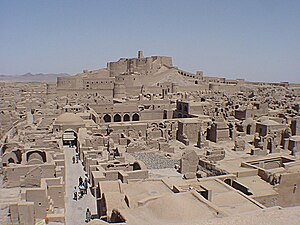Bam, Iran
|
Bam بم |
|
|---|---|
| city | |

Bam in 2002.
|
|
| Coordinates: 29°06′22″N 58°21′25″E / 29.10611°N 58.35694°ECoordinates: 29°06′22″N 58°21′25″E / 29.10611°N 58.35694°E | |
| Country |
|
| Province | Kerman |
| County | Bam |
| Bakhsh | Central |
| Elevation | 1,061 m (3,481 ft) |
| Population (2006) | |
| • Total | 73,823 |
| Time zone | IRST (UTC+3:30) |
| • Summer (DST) | IRDT (UTC+4:30) |
| Bam and its Cultural Landscape | |
|---|---|
| Name as inscribed on the World Heritage List | |
 |
|
| Location |
|
| Type | Cultural |
| Criteria | ii, iii, iv, v |
| Reference | 1208 |
| UNESCO region | Asia-Pacific |
| Inscription history | |
| Inscription | 2004 (28th Session) |
| Endangered | 2004— |
Bam (Persian: بم) is a city in and the capital of Bam County, Kerman Province, Iran. At the 2006 census, its population was 73,823, in 19,572 families.
The modern Iranian city of Bam surrounds the Bam citadel. Before the 2003 earthquake the official population count of the city was roughly 43,000. There are various opinions about the date and reasons for the foundation of the citadel. Some people believe that Bam city was founded during the Parthian Empire. Economically and commercially, Bam occupied a very important place in the region and was famed for its textiles and clothes. Ibn Hawqal (943–977), the Arab traveller and geographer, wrote of Bam in his book Surat-ul-`ard (The Earth-figure):
The ancient citadel of Arg-é Bam has a history dating back around 2,000 years ago, to the Parthian Empire (248 BC–224 AD), but most buildings were built during the Safavid dynasty. The city was largely abandoned due to an Afghan invasion in 1722. Subsequently, after the city had gradually been re-settled, it was abandoned a second time due to an attack by invaders from Shiraz. It was also used for a time as an army barracks.
The modern city of Bam was established later than the old citadel. It has gradually developed as an agricultural and industrial centre, and until the 2003 earthquake was experiencing rapid growth. In particular, the city is known for its dates and citrus fruit, irrigated by a substantial network of qanats. The city also benefited from tourism, with an increasing number of people visiting the ancient citadel in recent years.
...
Wikipedia

